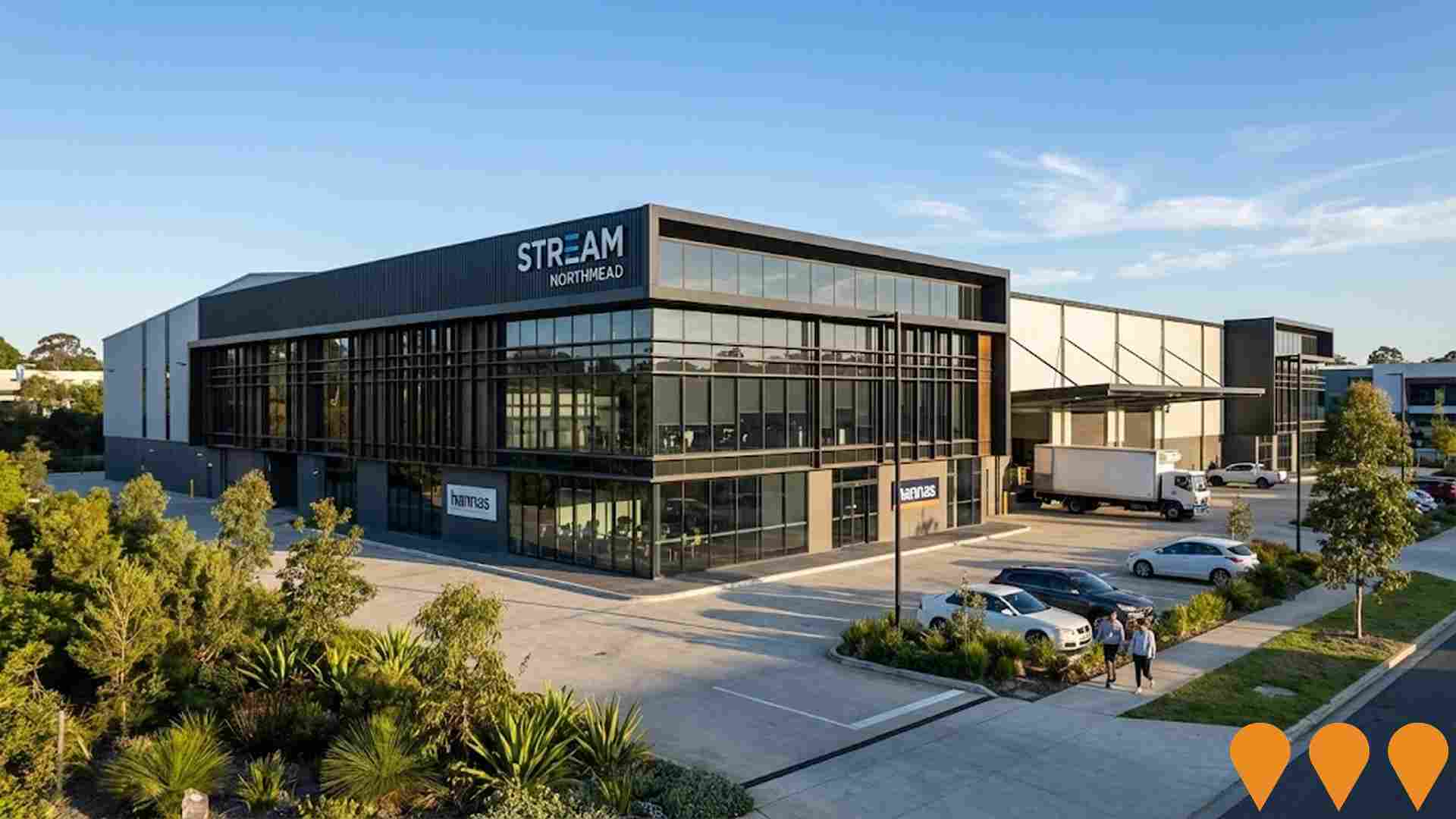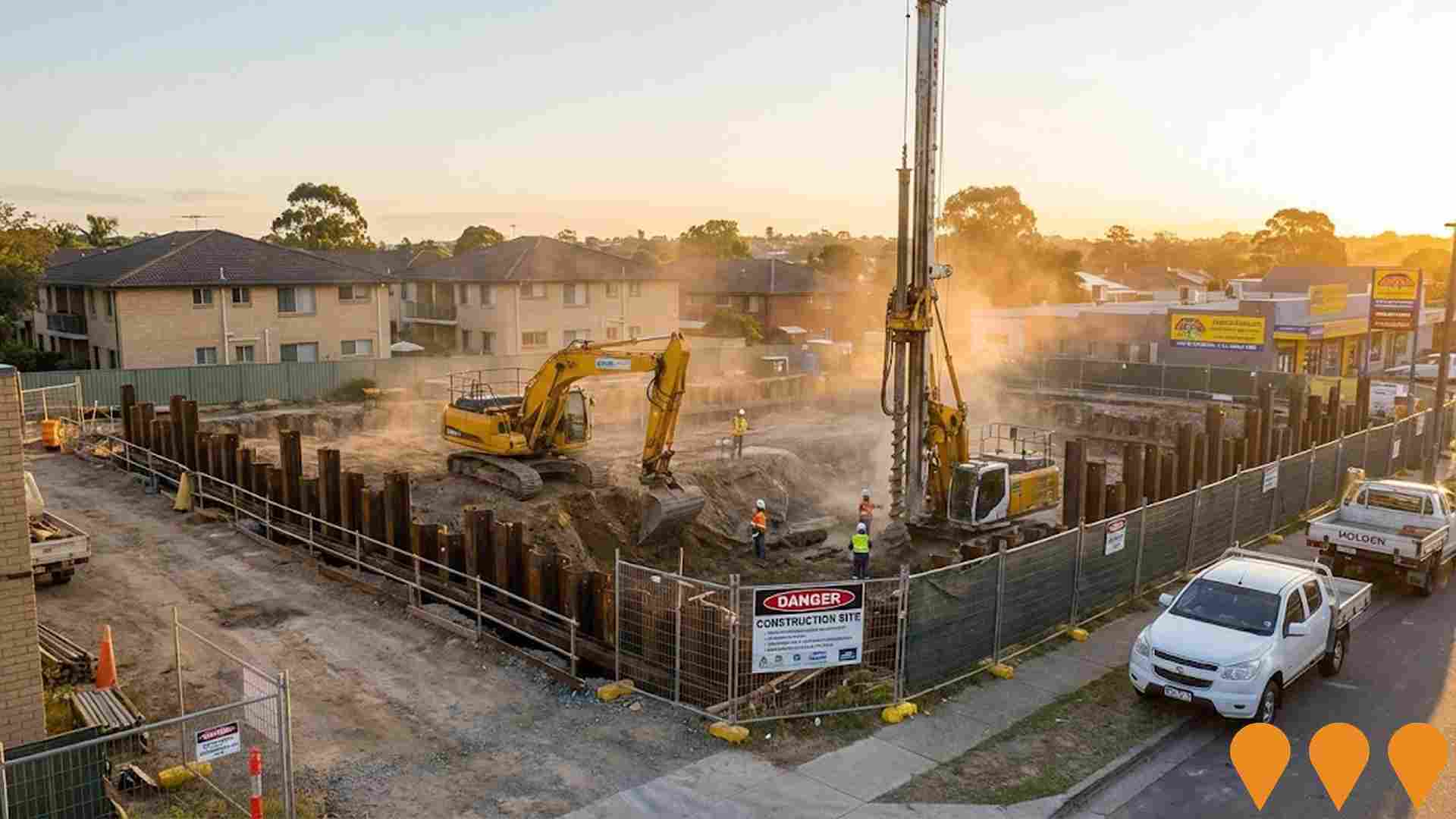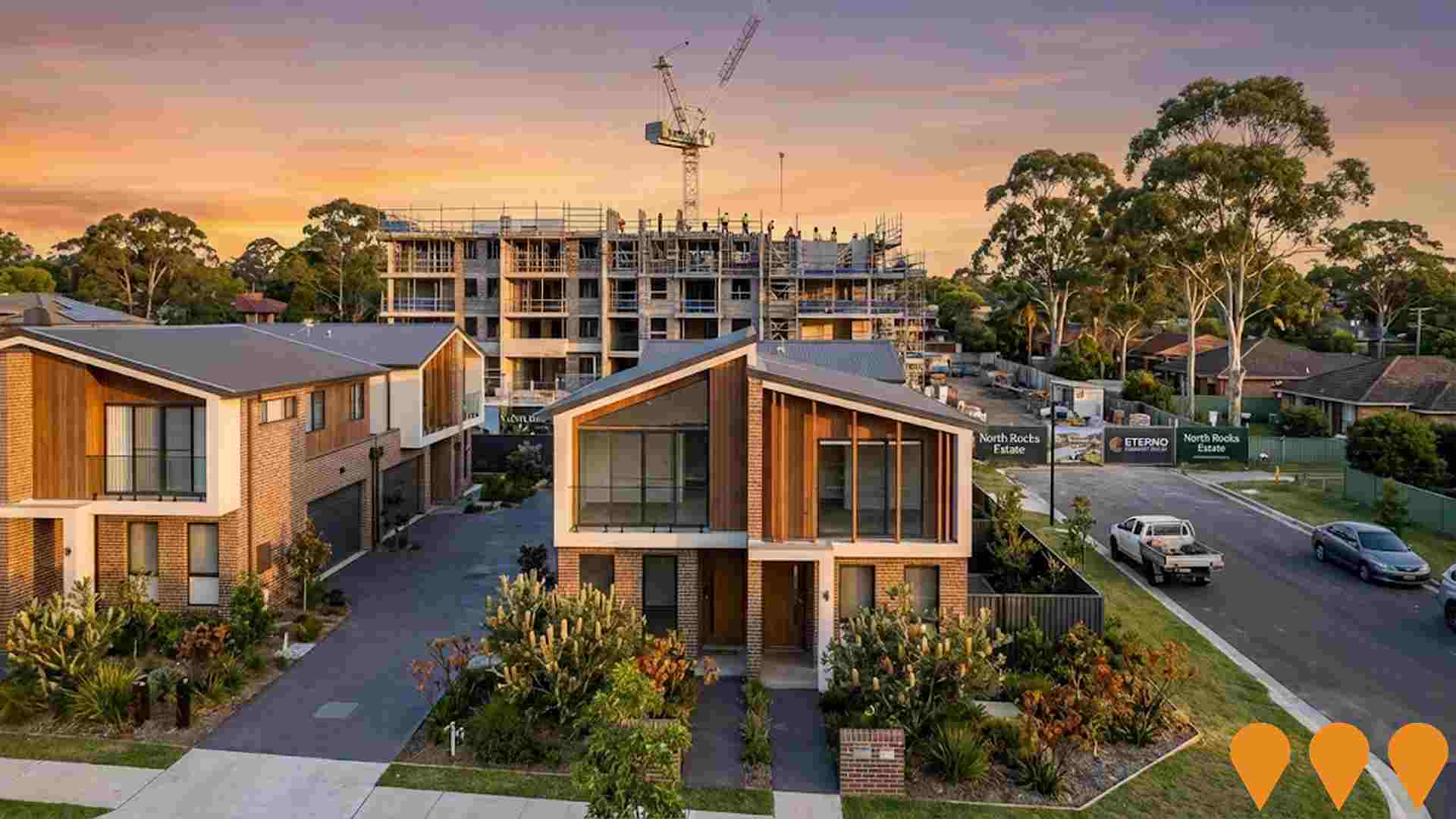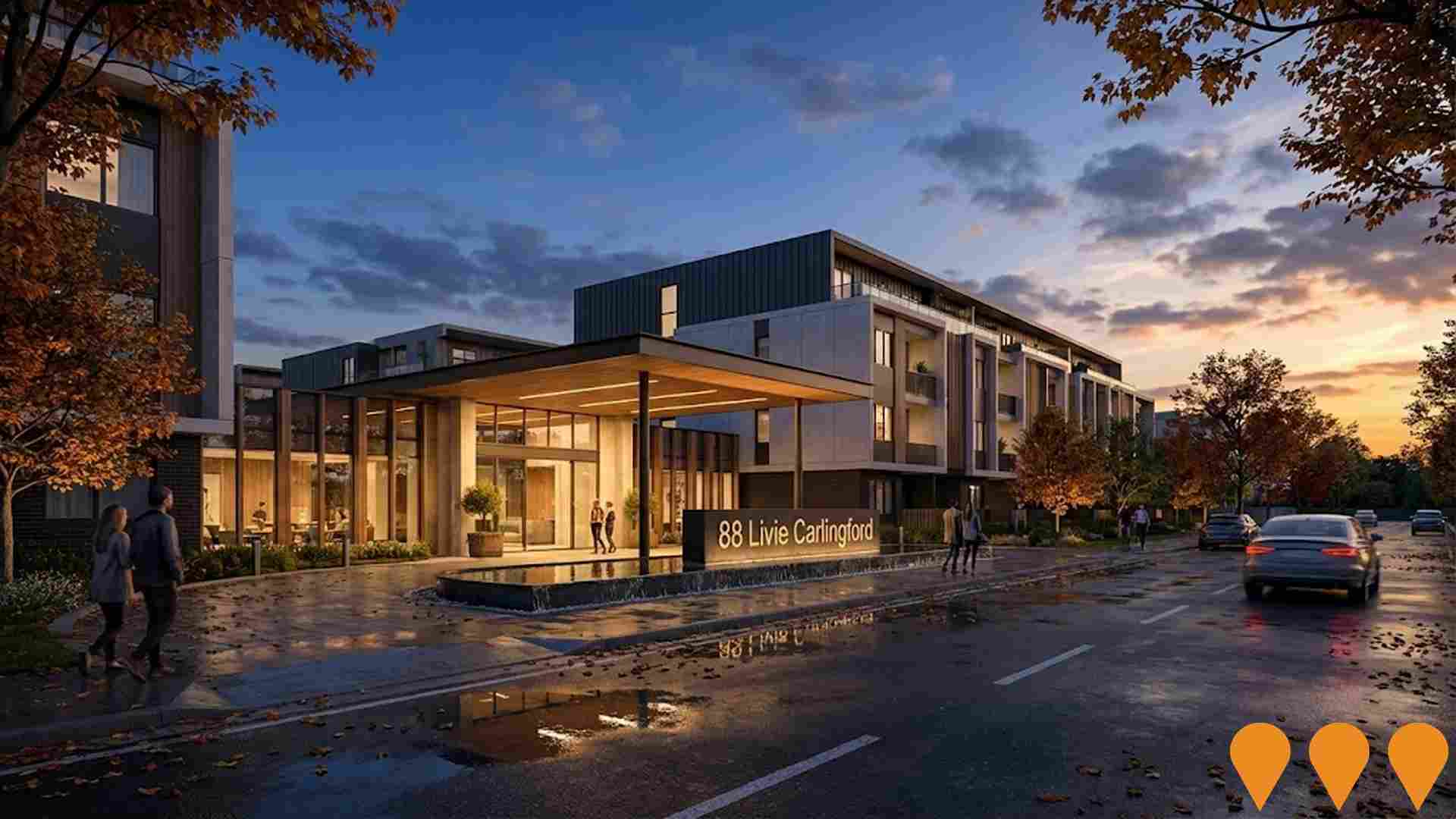Chart Color Schemes
est. as @ -- *
ABS ERP | -- people | --
2021 Census | -- people
Sales Activity
Curious about local property values? Filter the chart to assess the volume and appreciation (including resales) trends and regional comparisons, or scroll to the map below view this information at an individual property level.
Find a Recent Sale
Sales Detail
Population
An assessment of population growth drivers in North Rocks reveals an overall ranking slightly below national averages considering recent, and medium term trends
North Rocks' population is 8,704 as of November 2025. This figure reflects an increase of 253 people since the 2021 Census, which reported a population of 8,451. The change was inferred from ABS's estimated resident population of 8,692 in June 2024 and an additional 30 validated new addresses since the Census date. This results in a population density ratio of 1,617 persons per square kilometer, higher than the average seen across national locations assessed by AreaSearch. Overseas migration drove recent population growth, contributing approximately 91.1% of overall gains.
AreaSearch uses ABS/Geoscience Australia projections for each SA2 area, released in 2024 with a base year of 2022. For areas not covered by this data, AreaSearch utilises NSW State Government's SA2 level projections released in 2022 with a base year of 2021. Growth rates by age group from these aggregations are applied to all areas for years 2032 to 2041. Looking ahead, lower quartile growth is anticipated nationally, with North Rocks expected to grow by 199 persons to 2041 based on the latest population numbers, reflecting a total increase of 2.1% over the 17-year period.
Frequently Asked Questions - Population
Development
Residential development activity is lower than average in North Rocks according to AreaSearch's national comparison of local real estate markets
North Rocks has seen approximately 18 new homes approved annually over the past five financial years, totalling 93 homes. As of FY26, 8 approvals have been recorded. On average, 3.2 new residents arrive per year for each dwelling constructed between FY21 and FY25. Commercial development approvals amounting to $28.0 million have been recorded in the current financial year.
North Rocks records significantly lower building activity compared to Greater Sydney (70.0% below regional average per person) and nationally, indicating maturity and possible planning constraints. New developments consist of 73.0% standalone homes and 27.0% townhouses or apartments. With around 643 people per dwelling approval, North Rocks reflects a highly mature market. Future projections estimate an addition of 187 residents by 2041, suggesting that current housing supply should meet demand adequately, favourable for buyers with potential growth exceeding forecasts.
Future projections show North Rocks adding 187 residents by 2041. With current construction levels, housing supply should adequately meet demand, creating favourable conditions for buyers while potentially enabling growth that exceeds current forecasts.
Frequently Asked Questions - Development
Infrastructure
North Rocks has very high levels of nearby infrastructure activity, ranking in the top 10% nationally
Changes in local infrastructure significantly impact an area's performance. AreaSearch has identified 15 projects likely to affect the area. Notable projects include North Rocks Estate at 19-23 North Rocks Road, developments at 361-365 North Rocks Road, Wade Street Towers Refurbishment, and North Rocks Shopping Centre Redevelopment. The following list details those most relevant.
Professional plan users can use the search below to filter and access additional projects.
INFRASTRUCTURE SEARCH
 Denotes AI-based impression for illustrative purposes only, not to be taken as definitive under any circumstances. Please follow links and conduct other investigations from the project's source for actual imagery. Developers and project owners wishing us to use original imagery please Contact Us and we will do so.
Denotes AI-based impression for illustrative purposes only, not to be taken as definitive under any circumstances. Please follow links and conduct other investigations from the project's source for actual imagery. Developers and project owners wishing us to use original imagery please Contact Us and we will do so.
Frequently Asked Questions - Infrastructure
The Children's Hospital at Westmead Redevelopment
NSW Government $870 million redevelopment of The Children's Hospital at Westmead, delivering a new state-of-the-art Paediatric Services Building (12 levels), expanded Emergency Department, refurbished clinical wards, new medical imaging, and integrated cancer centre. The multi-storey car park (1,250 spaces) opened June 2024. Main clinical building remains on track for completion late 2025 with services commissioning through 2026.
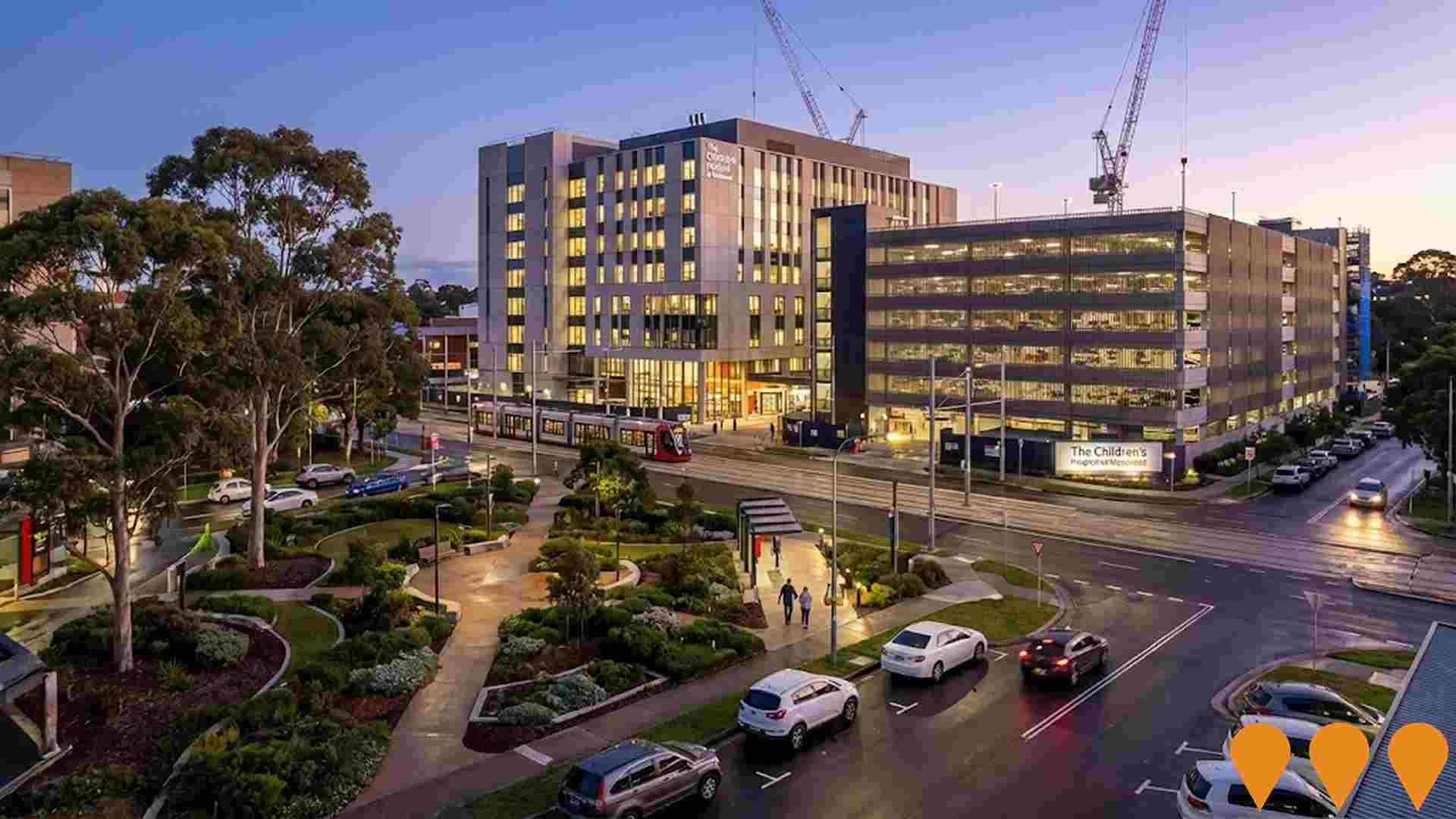
North Rocks Shopping Centre Redevelopment
Extension and upgrade of North Rocks Shopping Centre delivering a new full line Coles supermarket, expanded fresh food precinct, new mall area, additional specialty tenancies, and new basement and rooftop parking. The project reconfigured the existing centre to improve circulation and dining, and has been completed and trading since 2019. :contentReference[oaicite:0]{index=0} :contentReference[oaicite:1]{index=1} :contentReference[oaicite:2]{index=2}
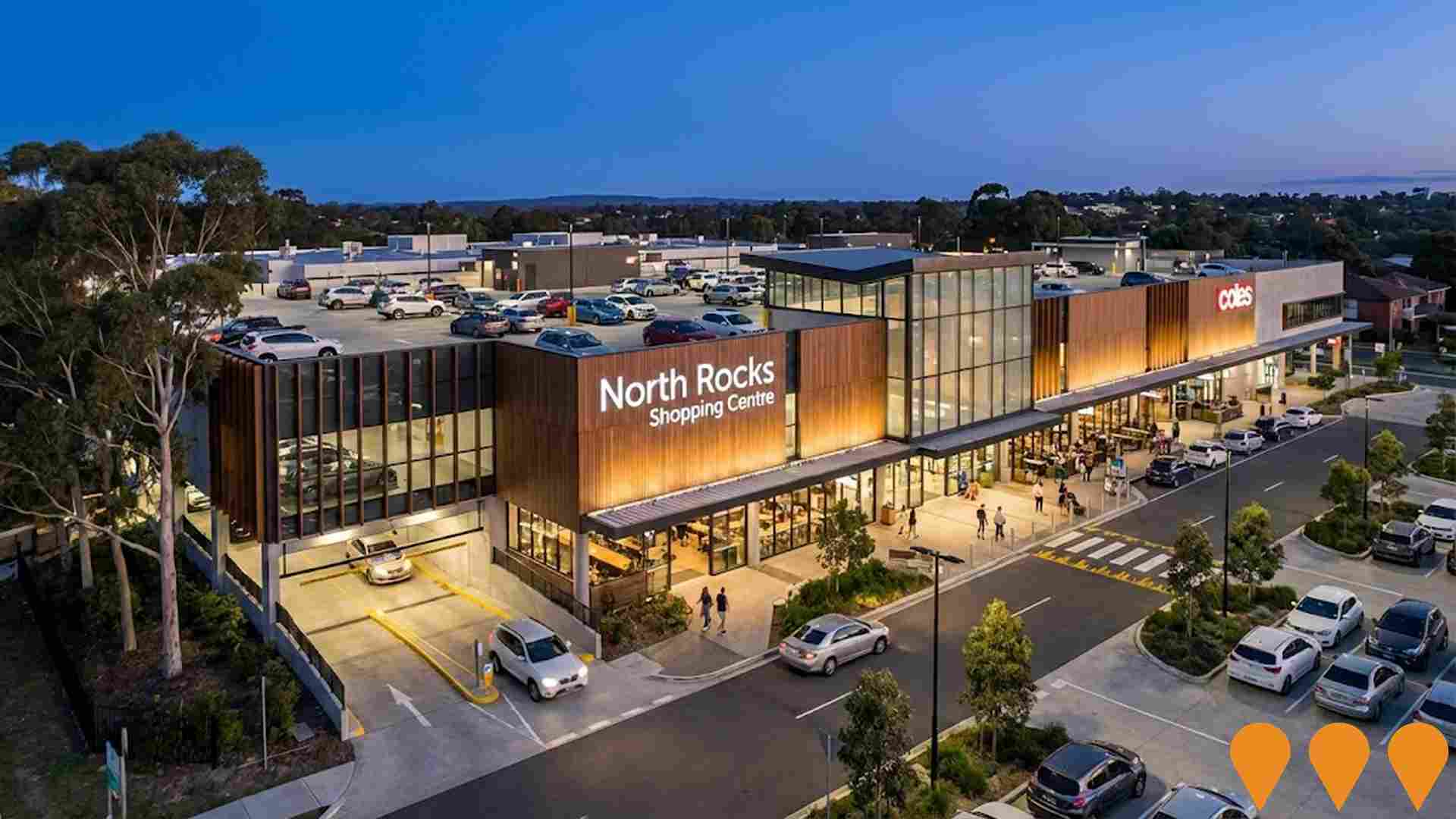
Pennant Hills Road and North Rocks Road Upgrade
Major intersection upgrade to ease congestion, reduce travel times and improve safety for road users. Part of NSW Government's $450 million Urban Roads Congestion Program. Construction commenced August 2024, expected completion mid-2027.
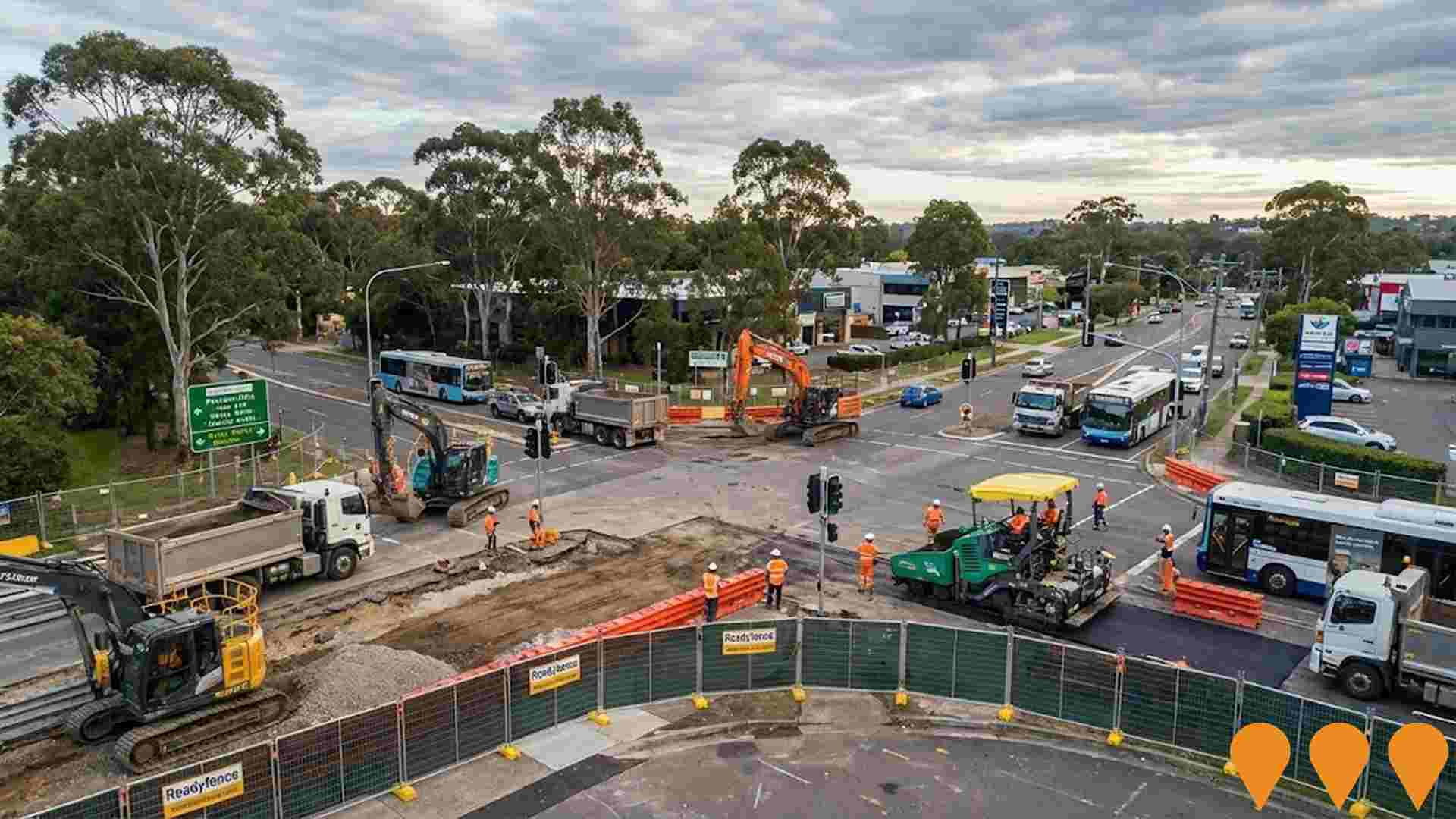
Bellevue Residences
A major master-planned community development by Aqualand on a 12.5 hectare site, part of a $480 million Norwest masterplan. The development includes multiple stages with land lots starting from 705sqm, future townhouses and apartments. Stage 1 'The Aster Collection' comprises 14 premium land lots, with future stages planned to include 110 medium density townhouses and 270 apartments across eight buildings. Located 600m from Norwest Metro Station and close to Norwest Business Park.

Regis Carlingford Aged Care Facility
Development of a 99-bed residential aged care facility across three storeys, designed to provide high-quality aged care services to the Carlingford community. The facility will feature generous floor to space ratios for residents and modern amenities.
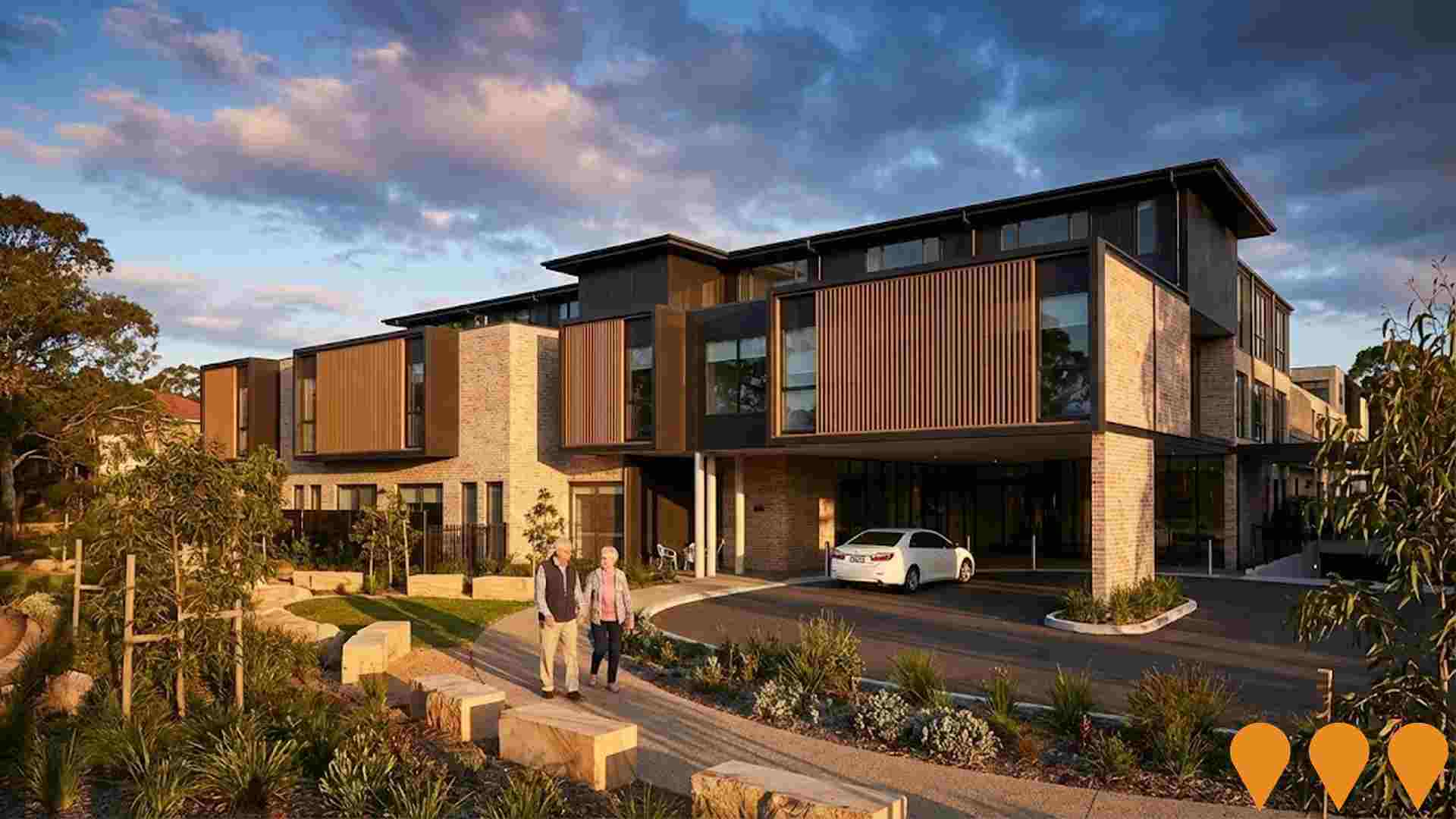
361-365 North Rocks Road Development
Mixed-use development on former Royal Institute for Deaf and Blind Children site. 560 apartments, 225 townhouses, 10 detached dwellings, 130 independent living units, 100-bed aged care facility, 16 affordable housing dwellings, 4.3ha public open space including oval, 4,400sqm community facilities, 2,800sqm commercial space.

Wade Street Towers Refurbishment
The refurbishment of the three high-rise buildings known as the 'Three Sisters' on Wade Street. The project will bring 148 vacant public housing units back into use, providing homes for approximately 240 residents. This initiative is an interim measure to address immediate housing needs while the long-term plans for the broader Telopea renewal are being developed. Works commenced in 2025 with completion expected end of 2025.

St Michel North Rocks
Premium over 55s retirement village at 201 North Rocks Road, North Rocks, offering 128 independent living units with resort style facilities including pool, gym, cinema and clubhouse. The village was delivered in stages between 2021 and 2024 and is operated by Keyton Retirement Living, providing low maintenance homes and a secure, community focused environment for independent seniors.
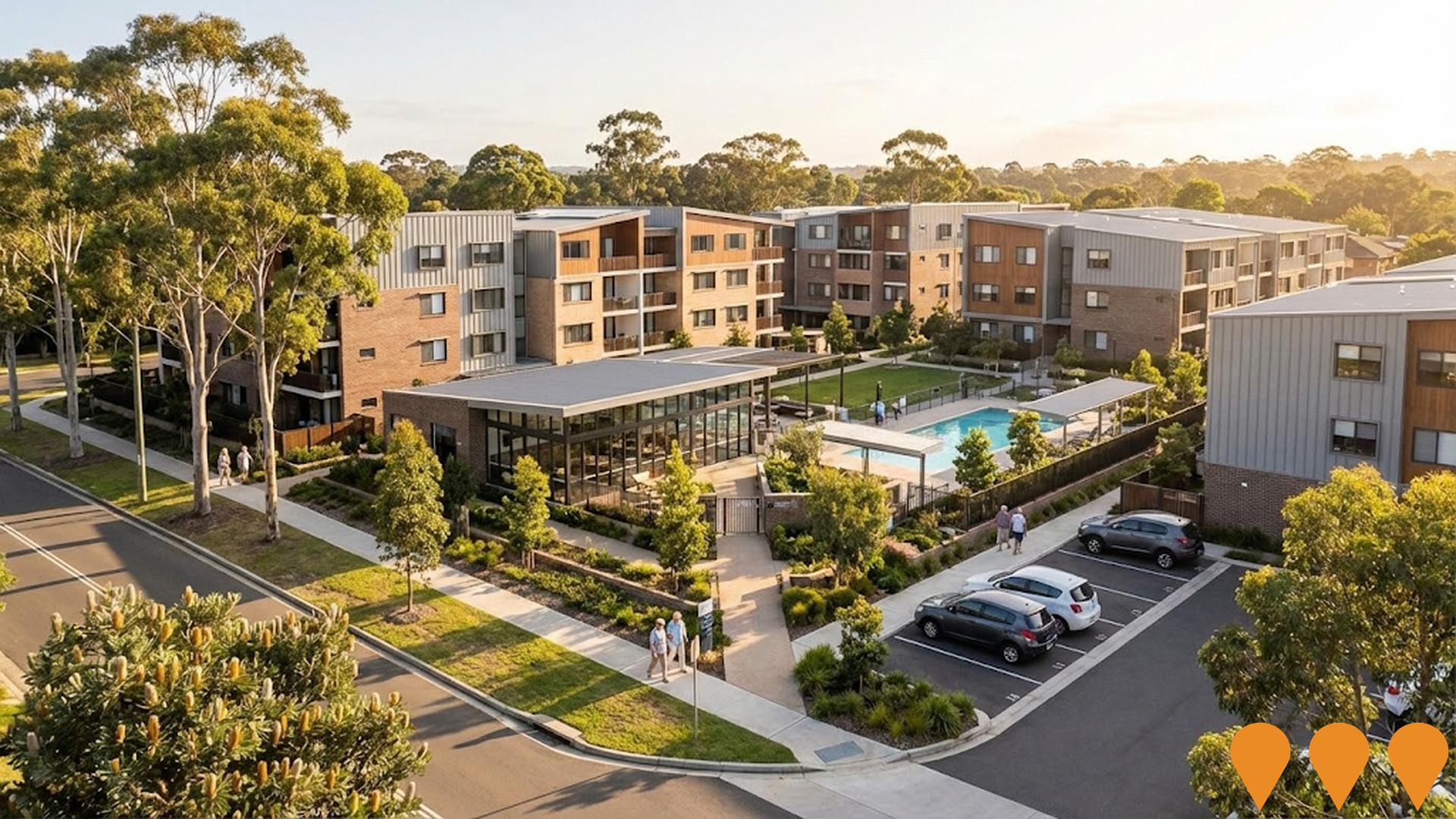
Employment
Employment conditions in North Rocks rank among the top 10% of areas assessed nationally
North Rocks has a highly educated workforce with prominent professional services. Its unemployment rate was 1.6% in the past year, with an estimated employment growth of 2.7%.
As of June 2025, there are 5,162 employed residents, with an unemployment rate of 2.6%, lower than Greater Sydney's 4.2%. Workforce participation is similar to Greater Sydney at 60.0%. Key industries include health care & social assistance, professional & technical services, and education & training, with notable concentration in the latter (1.3 times regional average). Transport, postal & warehousing has limited presence (3.5% vs regional 5.3%).
Many residents commute elsewhere for work based on Census data analysis. Between June 2024 and June 2025, employment levels increased by 2.7%, labour force grew by 3.1%, causing unemployment to rise by 0.4 percentage points. In comparison, Greater Sydney saw employment growth of 2.6% and labour force growth of 2.9%, with a 0.3 percentage point increase in unemployment. Jobs and Skills Australia forecasts national employment growth at 6.6% over five years and 13.7% over ten years. Applying these projections to North Rocks' employment mix suggests local growth of approximately 6.9% over five years and 14.1% over ten years, based on simple weighting extrapolation for illustrative purposes.
Frequently Asked Questions - Employment
Income
Income metrics indicate excellent economic conditions, with the area achieving higher performance than 75% of national locations assessed by AreaSearch
North Rocks had a median taxpayer income of $56,601 and an average of $71,551 according to AreaSearch's postcode level ATO data for the financial year 2022. These figures are high nationally compared to Greater Sydney's median income of $56,994 and average income of $80,856. Based on a 12.61% growth in wages since FY 2022, estimated incomes for September 2025 would be approximately $63,738 (median) and $80,574 (average). According to the Census 2021 income data, household incomes rank at the 88th percentile with weekly earnings of $2,399. The dominant earnings bracket is $1,500 - 2,999, with 30.3% of residents earning within this range. High weekly earnings exceed $3,000 for 39.4% of households, indicating strong consumer spending despite high housing costs consuming 16.1% of income. Disposable income ranks at the 86th percentile and the area's SEIFA income ranking places it in the 9th decile.
Frequently Asked Questions - Income
Housing
North Rocks is characterized by a predominantly suburban housing profile, with above-average rates of outright home ownership
North Rocks' dwelling structures, as per the latest Census, consisted of 86.0% houses and 14.0% other dwellings (semi-detached, apartments, 'other'). In comparison, Sydney metro had 36.4% houses and 63.6% other dwellings. Home ownership in North Rocks stood at 39.9%, with mortgaged dwellings at 42.2% and rented at 18.0%. The median monthly mortgage repayment was $2,945, above Sydney metro's average of $2,167. The median weekly rent was $550, compared to Sydney metro's $420. Nationally, North Rocks' mortgage repayments were higher at $2,945 vs Australia's average of $1,863, and rents were substantially above the national figure of $375.
Frequently Asked Questions - Housing
Household Composition
North Rocks features high concentrations of family households, with a higher-than-average median household size
Family households account for 84.6% of all households, including 48.7% that are couples with children, 25.8% that are couples without children, and 9.5% that are single parent families. Non-family households make up the remaining 15.4%, with lone person households at 13.9% and group households comprising 1.5% of the total. The median household size is 3.0 people, which is larger than the Greater Sydney average of 2.6.
Frequently Asked Questions - Households
Local Schools & Education
Educational achievement in North Rocks places it within the top 10% nationally, reflecting strong academic performance and high qualification levels across the community
Educational attainment in North Rocks is notably high, with 43.9% of residents aged 15 and above holding university qualifications, compared to 30.4% nationally and 32.2% statewide (NSW). The area's Bachelor degree holders comprise 28.1%, followed by postgraduate qualifications at 12.7% and graduate diplomas at 3.1%. Vocational credentials are also prevalent, with 27.3% of residents aged 15 and above holding such qualifications, including advanced diplomas (11.9%) and certificates (15.4%). Educational participation is high, with 30.7% of residents currently enrolled in formal education, including 11.1% in primary, 8.5% in secondary, and 5.6% pursuing tertiary education.
North Rocks has three schools with a combined enrollment of 2,078 students as of the latest data. The area demonstrates significant socio-educational advantages and academic achievement, with an ICSEA score of 1107. Education provision is balanced, with two primary and one secondary school serving distinct age groups. School capacity exceeds typical residential needs, with 23.9 places per 100 residents compared to the regional average of 18.0, indicating that North Rocks serves as an educational center for the broader region.
Frequently Asked Questions - Education
Schools Detail
Nearby Services & Amenities
Transport
Transport servicing is high compared to other areas nationally based on assessment of service frequency, route connectivity and accessibility
North Rocks has 74 active public transport stops, all of which are bus stops. These stops are served by 44 different routes that together facilitate 3,837 weekly passenger trips. The accessibility of these services is rated excellent, with residents typically located just 148 meters from the nearest stop.
On average, there are 548 trips per day across all routes, which equates to approximately 51 weekly trips per individual stop.
Frequently Asked Questions - Transport
Transport Stops Detail
Health
North Rocks's residents are extremely healthy with both young and old age cohorts seeing low prevalence of common health conditions
Analysis of health metrics indicates robust performance across North Rocks, with both younger and older age groups exhibiting low prevalence rates for common health conditions.
Approximately 4813 people, or roughly 55% of the total population, have private health cover. The most prevalent medical conditions in the area are arthritis and asthma, affecting 7.1 and 6.3% of residents respectively. A significant majority, 74.1%, report being completely free from medical ailments, compared to 79.0% across Greater Sydney. As of 2021, 19.2% of North Rocks' residents are aged 65 and over (constituting 1669 people), which is higher than the 12.5% figure for Greater Sydney. Despite this, health outcomes among seniors in North Rocks align closely with those of the general population.
Frequently Asked Questions - Health
Cultural Diversity
North Rocks is among the most culturally diverse areas in the country based on AreaSearch assessment of a range of language and cultural background related metrics
North Rocks has a high level of cultural diversity, with 40.8% of its population born overseas and 42.4% speaking a language other than English at home. The predominant religion in North Rocks is Christianity, comprising 53.2% of the population. However, Buddhism is notably overrepresented, making up 3.8% compared to Greater Sydney's average of 2.9%.
In terms of ancestry, the top three groups are Chinese (18.2%, regional average: 8.7%), English (17.6%, regional average: 12.2%), and Australian (17.5%, regional average: 11.8%). Other ethnic groups with notable differences include Korean (4.3% vs regional 1.5%), Lebanese (2.7% vs 3.5%), and Sri Lankan (0.7% vs 0.9%).
Frequently Asked Questions - Diversity
Age
North Rocks's median age exceeds the national pattern
North Rocks's median age is 41 years, which is significantly higher than Greater Sydney's average of 37 years and slightly above Australia's median of 38 years. Compared to Greater Sydney, North Rocks has an over-representation of the 5-14 age cohort at 15.3% and an under-representation of the 25-34 age group at 8.4%. According to the 2021 Census, the population aged 15-24 years increased from 11.2% to 12.9%, while the 55-64 age group decreased from 12.1% to 11.2%. By 2041, demographic modeling projects significant changes in North Rocks's age profile. The 85+ cohort is expected to grow by 137%, adding 210 residents to reach 365. Residents aged 65 and older are projected to represent 65% of the population growth. Conversely, population declines are anticipated for the 25-34 and 0-4 age groups.

